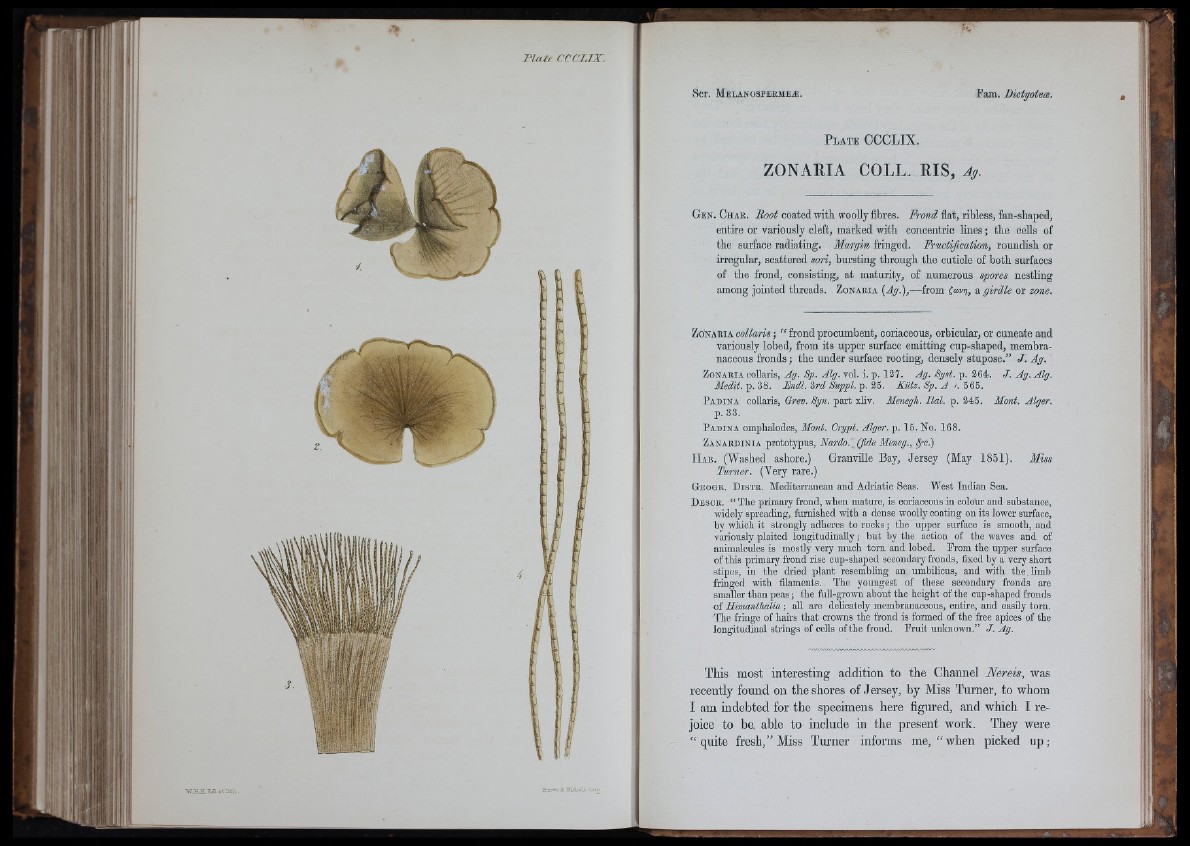
kÁ!i
__
F I lUi c c c i j x .
'W .H J l . a i le t 'l i f k . & UitOiols un.p
ZONARIA COLL. RIS, Ag.
Gen . Chak. Root coated with woolly fibres. Frond flat, ribless, fan-shaped,
entire or variously cleft, marked with concentric lines; the cells of
the surface radiating. Margin fringed. Fructijication, roundish or
irregular, scattered sori, bursting through the cuticle of both surfaces
of the frond, consisting, at maturity, of numerous spores nestling
among jointed threads. Z o n a r i a [A g ) ,—from (aon), a girdle or zone.
Z o n a r i a collaris; “ frond procumbent, coriaceous, orbicular, or cuneate and
variously lobed, from its upper surface emitting cup-shaped, membranaceous
fronds; the under surface rooting, densely stupose.” J . Ag.
Zonaria collaris, Ag. Sp. Alg. vol, i. p. 127. Ag. Syst. p. 264. J. Ag.Alg.
Medit. p. 38. Fndl. 3rd Suppl. p. 25. Kiitz. Sp. A t. 565.
P a d in a coUaris, Qree. Syn. part xliv. Menegh. Ital. p. 245. Mont. Alger.
p . 33.
P adina omphalodes, Mont. Crypt. Alger, p. IB, No. 168.
Za n a rd in ia prototypus, Nardo.iQide Meneg., §-c)
H a b . (Washed ashore.) Granville Bay, Jersey (May 1 8 5 1 ). Miss
Turner. (Very rare.)
Geogr. D istk . Mediterranean and Adi-iatic Seas. West Indian Sea.
D esor. “ The primary frond, when mature, is coriaceous in colour and substance,
widely spreading, furnished with a dense woolly coating on its lower surface,
by which it strongly adheres to rocks; the upper surface is smooth, and
variously plaited longitudinally; but by the action of the waves and of
animalcules is mostly very much torn and lobed. From the upper suiface
of tliis primary frond rise cup-shaped secondary fronds, fixed by a very short
stipes, in the dried plant resembling an umbilicus, and with the limb
fringed with filaments. The youngest of these secondary fronds are
smaller than peas; the full-grown about the height of the cup-shaped fronds
of Himanthalia; aU. are delicately membranaceous, entire, and easily torn.
The fringe of hairs that crowns the frond is formed of the free apices of the
longitudinal strings of cells of the frond. Fruit unknown,” J .A g .
This most interesting addition to the Channel Nereis, was
recently found on the shores of Jersey, by Miss Turner, to whom
I am indebted for the specimens here figured, and which I rejoice
to be. able to include in the present work. They were
“ quite fresh,” Miss Turner informs me, “ when picked u p ;
- I